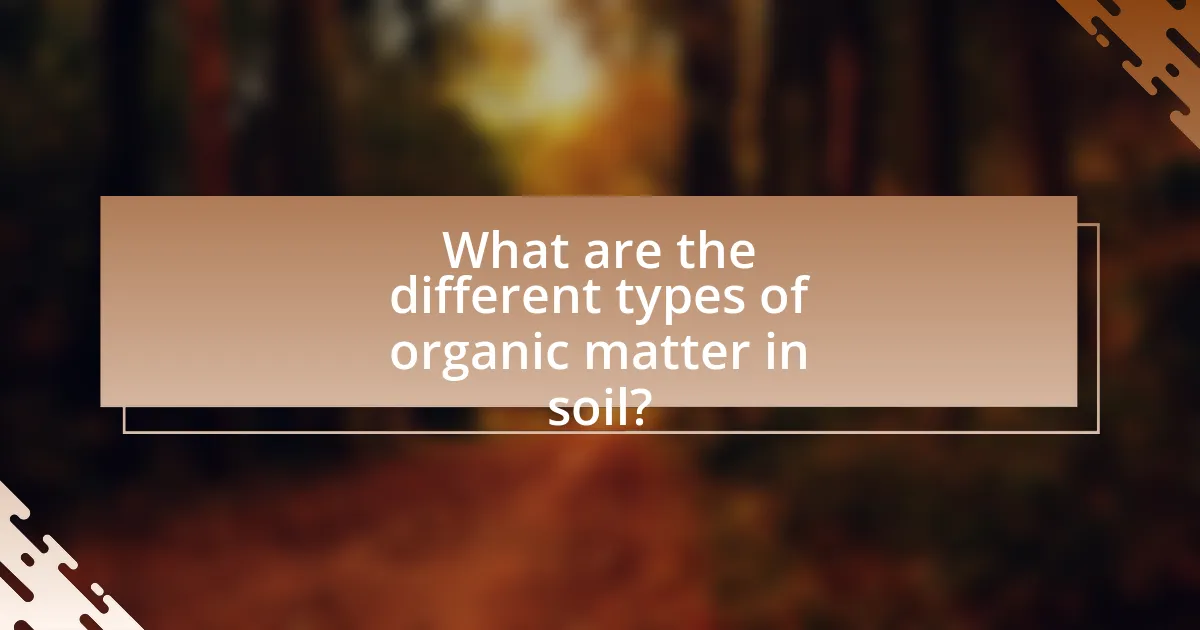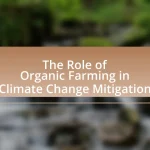The article focuses on the impact of organic matter on soil structure and fertility, highlighting its crucial role in enhancing soil aggregation, porosity, and nutrient availability. It discusses how organic matter improves physical properties of soil, such as water retention and aeration, and emphasizes its significance in agricultural productivity by increasing crop yields. The article also examines various sources of organic matter, including plant residues, animal manure, and compost, and outlines best practices for enhancing organic matter content in soil, while addressing challenges posed by climate change and land management practices. Overall, it underscores the importance of organic matter in maintaining healthy soil ecosystems and promoting sustainable agriculture.

What is the impact of organic matter on soil structure and fertility?
Organic matter significantly enhances soil structure and fertility. It improves soil aggregation, which increases porosity and aeration, allowing for better water infiltration and root penetration. Additionally, organic matter serves as a reservoir of nutrients, releasing essential elements like nitrogen, phosphorus, and potassium as it decomposes, thereby promoting plant growth. Studies have shown that soils rich in organic matter can yield up to 20% more crops compared to those with low organic content, highlighting its critical role in agricultural productivity.
How does organic matter influence soil physical properties?
Organic matter significantly enhances soil physical properties by improving soil structure, water retention, and aeration. The presence of organic matter, such as decomposed plant and animal materials, promotes the formation of soil aggregates, which leads to better soil porosity and reduces compaction. Research indicates that soils rich in organic matter can retain up to 20% more water than those with low organic content, thereby improving moisture availability for plants. Additionally, organic matter increases the soil’s ability to hold nutrients, which further supports plant growth and soil fertility.
What role does organic matter play in soil aggregation?
Organic matter significantly enhances soil aggregation by promoting the formation of stable soil aggregates. These aggregates improve soil structure, increase porosity, and enhance water retention. Research indicates that organic matter, such as decomposed plant material and microbial biomass, acts as a binding agent, facilitating the clumping of soil particles. This process is crucial for soil health, as it enhances aeration and root penetration, ultimately leading to improved nutrient availability and soil fertility. Studies have shown that soils rich in organic matter can have up to 30% greater aggregate stability compared to those with low organic content, demonstrating the vital role of organic matter in maintaining soil structure.
How does organic matter affect soil porosity and aeration?
Organic matter significantly enhances soil porosity and aeration by improving soil structure. When organic matter decomposes, it forms aggregates that create spaces between soil particles, increasing the volume of pore spaces. These pore spaces facilitate air movement and water infiltration, which are crucial for root respiration and microbial activity. Research indicates that soils rich in organic matter can have up to 50% more porosity compared to those with low organic content, thereby promoting better aeration. This improved aeration supports healthy plant growth and enhances overall soil fertility.
Why is organic matter essential for soil fertility?
Organic matter is essential for soil fertility because it enhances nutrient availability, improves soil structure, and promotes microbial activity. The presence of organic matter increases the soil’s cation exchange capacity, allowing it to retain essential nutrients such as nitrogen, phosphorus, and potassium, which are vital for plant growth. Additionally, organic matter contributes to the formation of soil aggregates, improving aeration and water retention, which further supports healthy root development. Research indicates that soils rich in organic matter can yield up to 20% more crops compared to those with low organic content, demonstrating its critical role in agricultural productivity.
What nutrients are provided by organic matter?
Organic matter provides essential nutrients such as nitrogen, phosphorus, potassium, calcium, magnesium, and sulfur. These nutrients are critical for plant growth and soil health, as they contribute to various physiological processes in plants. For instance, nitrogen is vital for protein synthesis, phosphorus is important for energy transfer and root development, and potassium regulates water uptake and enzyme activation. The presence of organic matter enhances nutrient availability through microbial activity, which decomposes organic materials and releases these nutrients into the soil. Studies have shown that soils rich in organic matter can improve fertility and support higher crop yields, demonstrating the significant role of organic matter in sustainable agriculture.
How does organic matter enhance microbial activity in the soil?
Organic matter enhances microbial activity in the soil by providing essential nutrients and improving soil structure. The decomposition of organic matter releases carbon, nitrogen, and other nutrients that serve as food sources for microorganisms, promoting their growth and activity. Additionally, organic matter improves soil aeration and water retention, creating a favorable environment for microbial communities. Studies have shown that soils rich in organic matter can support higher microbial biomass and diversity, which are critical for nutrient cycling and soil health.

What are the different types of organic matter in soil?
The different types of organic matter in soil include plant residues, animal manures, compost, and humus. Plant residues consist of decomposed leaves, stems, and roots, which contribute nutrients and improve soil structure. Animal manures are organic materials derived from livestock, providing essential nutrients and enhancing microbial activity. Compost is a mixture of decomposed organic materials, such as kitchen scraps and yard waste, that enriches soil fertility and promotes healthy plant growth. Humus is the stable, well-decomposed organic matter that improves soil’s water retention and nutrient-holding capacity. These types of organic matter play a crucial role in enhancing soil structure and fertility, as evidenced by studies showing that soils rich in organic matter have better aeration, drainage, and nutrient availability.
What are the sources of organic matter in soil?
The sources of organic matter in soil include plant residues, animal manure, compost, and microbial biomass. Plant residues, such as leaves, stems, and roots, decompose and contribute to soil organic matter. Animal manure adds nutrients and organic material when it decomposes. Compost, created from decomposed organic materials, enriches soil fertility and structure. Microbial biomass, formed from the decomposition of organic materials by microorganisms, also contributes significantly to soil organic matter. These sources collectively enhance soil health, improve nutrient availability, and support soil structure.
How do plant residues contribute to soil organic matter?
Plant residues contribute to soil organic matter by decomposing and adding organic carbon and nutrients to the soil. As plant materials break down, they release essential elements such as nitrogen, phosphorus, and potassium, which enhance soil fertility. Research indicates that the incorporation of plant residues can increase soil organic carbon levels by 10-30% over time, improving soil structure and water retention. This process also fosters microbial activity, which further aids in the formation of stable organic matter complexes, thus reinforcing the soil’s overall health and productivity.
What is the significance of animal manure in soil fertility?
Animal manure significantly enhances soil fertility by providing essential nutrients, improving soil structure, and increasing microbial activity. The organic matter in animal manure contains nitrogen, phosphorus, and potassium, which are vital for plant growth. Studies have shown that the application of animal manure can increase soil organic carbon levels, leading to improved water retention and aeration. For instance, research published in the Journal of Soil Science and Plant Nutrition indicates that manure application can boost crop yields by 20-30% compared to chemical fertilizers alone, demonstrating its effectiveness in enhancing soil fertility.
How does the decomposition process affect organic matter?
The decomposition process transforms organic matter into simpler compounds, enhancing soil fertility and structure. During decomposition, microorganisms break down complex organic materials, releasing nutrients such as nitrogen, phosphorus, and potassium, which are essential for plant growth. This nutrient release improves soil fertility, making it more productive. Additionally, the process contributes to the formation of humus, a stable organic matter that enhances soil structure by improving aeration, water retention, and microbial activity. Studies show that soils rich in decomposed organic matter exhibit better physical properties, leading to increased agricultural productivity.
What factors influence the rate of organic matter decomposition?
The rate of organic matter decomposition is influenced by factors such as temperature, moisture, microbial activity, and the chemical composition of the organic material. Temperature affects enzymatic activity and microbial metabolism; for instance, higher temperatures generally accelerate decomposition rates. Moisture levels are crucial, as too little or too much water can hinder microbial processes. Microbial activity, driven by the presence of bacteria and fungi, is essential for breaking down organic matter; a diverse microbial community can enhance decomposition efficiency. Lastly, the chemical composition, including the carbon-to-nitrogen ratio, determines how readily organic matter can be decomposed; materials with a lower carbon-to-nitrogen ratio decompose faster. These factors collectively shape the dynamics of organic matter turnover in soil ecosystems.
How does the carbon-to-nitrogen ratio impact decomposition?
The carbon-to-nitrogen (C:N) ratio significantly impacts decomposition rates in organic matter. A lower C:N ratio, typically around 20:1 to 30:1, promotes faster decomposition because microorganisms have sufficient nitrogen to break down carbon-rich materials. Conversely, a higher C:N ratio, exceeding 30:1, slows decomposition as microorganisms struggle to find adequate nitrogen, leading to nutrient immobilization in the soil. Research indicates that optimal C:N ratios enhance microbial activity and nutrient cycling, which are crucial for soil fertility and structure.

How can we enhance organic matter content in soil?
To enhance organic matter content in soil, incorporate compost, cover crops, and crop residues into the soil. Compost adds decomposed organic materials that improve soil structure and nutrient availability. Cover crops, such as clover or rye, grow during off-seasons, preventing erosion and adding biomass when tilled back into the soil. Crop residues left on the field after harvest decompose over time, enriching the soil with organic matter. Research indicates that these practices can increase soil organic carbon levels significantly, improving overall soil fertility and structure.
What practices can increase organic matter in agricultural soils?
Practices that can increase organic matter in agricultural soils include cover cropping, crop rotation, reduced tillage, and the application of organic amendments such as compost and manure. Cover cropping, for instance, enhances soil organic matter by adding biomass and improving soil structure, which can lead to increased water retention and nutrient availability. Research indicates that cover crops can increase soil organic carbon levels by 0.5 to 1.5 tons per hectare annually. Crop rotation diversifies root structures and promotes microbial activity, further contributing to organic matter accumulation. Reduced tillage minimizes soil disturbance, preserving existing organic matter and enhancing soil health. The application of organic amendments like compost and manure not only adds nutrients but also significantly boosts soil organic matter content, with studies showing that compost can increase soil organic carbon by up to 2% over several years.
How does cover cropping contribute to organic matter levels?
Cover cropping significantly enhances organic matter levels in soil by introducing biomass that decomposes and enriches the soil. The roots of cover crops penetrate the soil, promoting microbial activity and increasing the accumulation of organic residues. Research indicates that cover crops can increase soil organic matter by 0.1 to 0.5% per year, depending on the species used and management practices. This increase in organic matter improves soil structure, water retention, and nutrient availability, ultimately contributing to enhanced soil fertility.
What is the role of composting in improving soil fertility?
Composting plays a crucial role in improving soil fertility by enhancing nutrient availability and soil structure. The decomposition of organic materials in compost results in the release of essential nutrients such as nitrogen, phosphorus, and potassium, which are vital for plant growth. Additionally, compost improves soil structure by increasing its organic matter content, leading to better aeration, water retention, and microbial activity. Research indicates that soils enriched with compost can exhibit up to a 30% increase in nutrient-holding capacity, thereby promoting healthier plant development and higher crop yields.
What are the challenges in maintaining organic matter in soil?
Maintaining organic matter in soil faces several challenges, including soil erosion, nutrient depletion, and land use changes. Soil erosion, caused by water and wind, removes the top layer of soil rich in organic matter, leading to reduced fertility. Nutrient depletion occurs when crops are harvested without adequate replenishment of organic matter, resulting in a decline in soil health. Additionally, land use changes, such as urbanization and intensive agriculture, disrupt the natural processes that contribute to organic matter accumulation. These factors collectively hinder the ability to sustain healthy levels of organic matter, which is crucial for soil structure and fertility.
How do land management practices affect organic matter retention?
Land management practices significantly influence organic matter retention by determining soil structure, microbial activity, and nutrient cycling. Practices such as cover cropping, reduced tillage, and organic amendments enhance organic matter retention by improving soil aggregation and fostering a conducive environment for microbial communities. For instance, studies have shown that reduced tillage can increase soil organic carbon levels by 20-30% compared to conventional tillage methods, as it minimizes soil disturbance and promotes the accumulation of organic residues. Additionally, the use of cover crops can contribute to organic matter retention by adding biomass to the soil, which decomposes and enriches the soil organic content. These practices collectively enhance soil fertility and structure, demonstrating the critical role of land management in organic matter dynamics.
What impact does climate change have on soil organic matter levels?
Climate change negatively impacts soil organic matter levels by accelerating decomposition rates and altering moisture availability. Increased temperatures enhance microbial activity, leading to faster breakdown of organic matter, while changes in precipitation patterns can either lead to soil erosion or waterlogging, both of which disrupt the accumulation of organic matter. Research indicates that a 1°C rise in temperature can increase decomposition rates by 10-20%, significantly reducing soil organic carbon stocks.
What are the best practices for managing organic matter in soil?
The best practices for managing organic matter in soil include incorporating diverse organic materials, maintaining proper moisture levels, and implementing crop rotation. Incorporating diverse organic materials, such as compost, green manure, and cover crops, enhances soil structure and fertility by increasing microbial activity and nutrient availability. Maintaining proper moisture levels is crucial, as organic matter decomposition is facilitated by adequate moisture, which supports microbial processes. Implementing crop rotation helps prevent nutrient depletion and promotes a balanced soil ecosystem, further enhancing organic matter content. Research indicates that these practices can significantly improve soil health, leading to increased agricultural productivity and sustainability.










